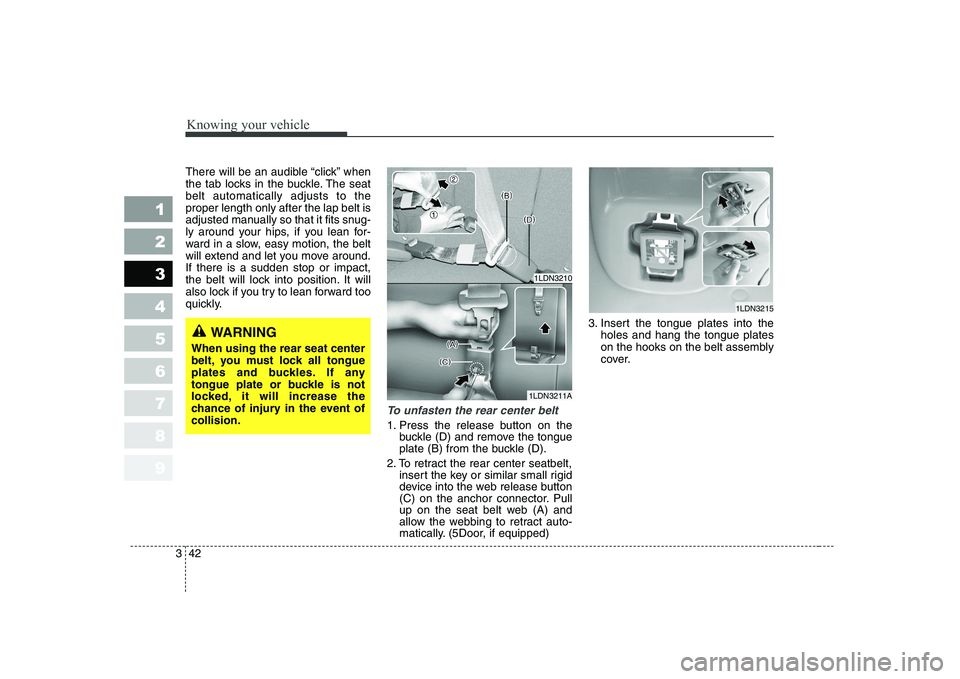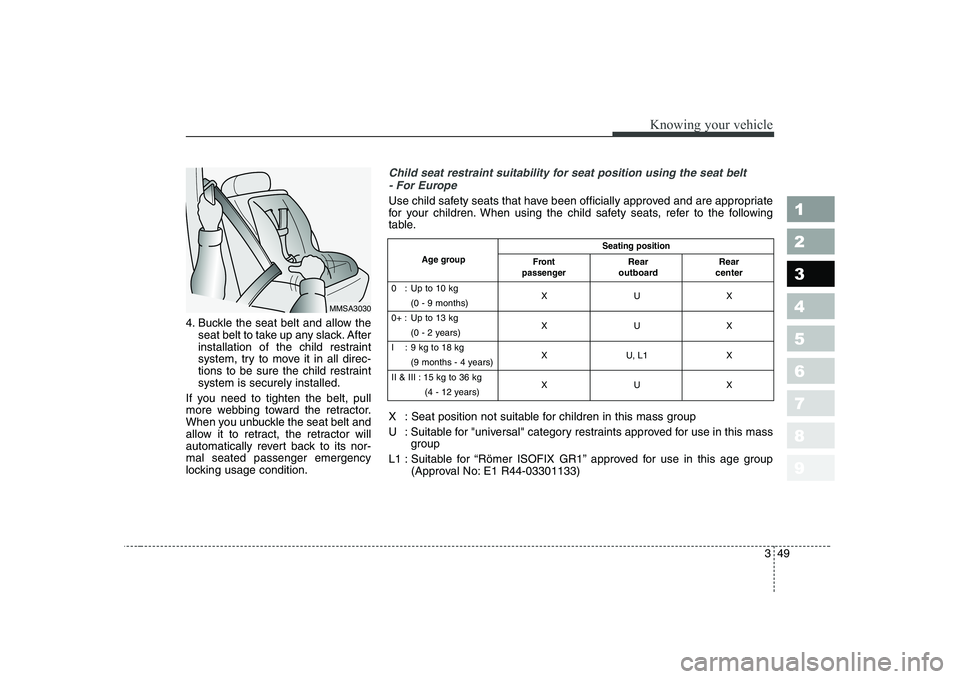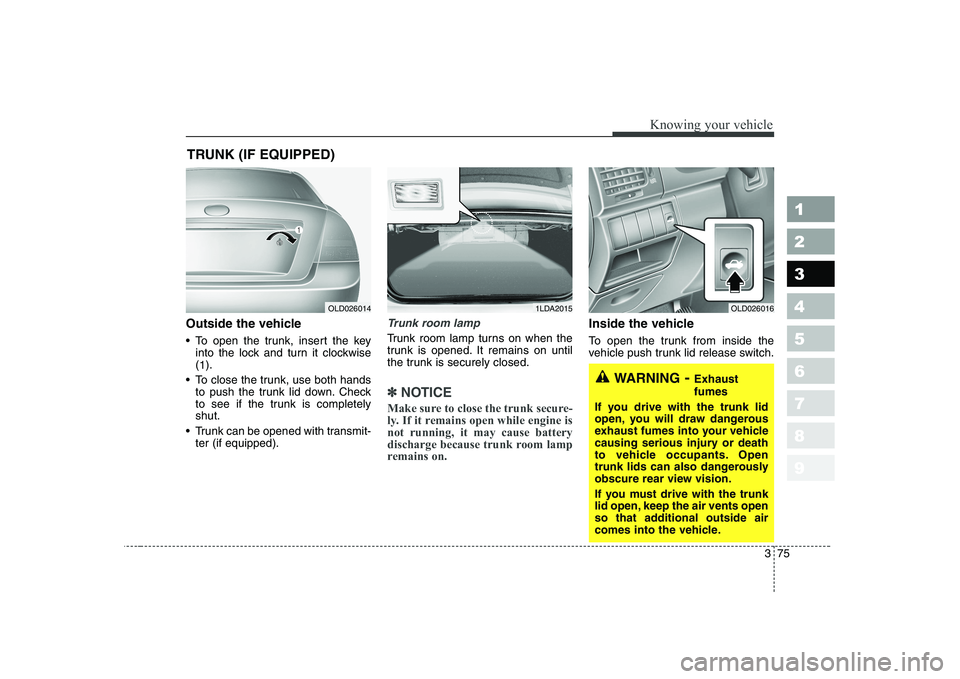Page 49 of 327
339
1 23456789
Knowing your vehicle
Lap belt (if equipped)
To fasten the lap belt:
1. Grasp the tongue and pull it lowover the abdomen.
2. Insert the tongue plate ( 1) into the
open end of the buckle ( 2) until an
audible “click” is heard, indicating
the latch is locked. Make sure thebelt is not twisted. 3. Grasp the free portion of the belt
webbing and pull until the belt is
snug over the hips and lower
abdomen. If it becomes necessary
to lengthen or shorten the belt,
hold the latch plate tongue at right
angles to the webbing and pull. 4. Make sure that the belt is placed
as LOW ON THE HIPS as possi-
ble.
OLD026300-1OLD026301OLD026302
Adjust to a snug fitKeep as low on hipbone as possible
Page 51 of 327
341
1 23456789
Knowing your vehicle
3 Point rear center belt (if equipped)
To fasten the rear center belt
1. Extract the tongue plates from theholes on the belt assembly cover
and slowly pull the tongue plates
out from the retractor. 2. Insert the tongue plate (A) into the
open end of the anchor connector
(C) until an audible “click" is heard,
indicating the latch is locked. Makesure the belt is not twisted. 3. Pull the tongue plate (B) and
insert the tongue plate (B) into the
open end of the buckle (D) until an
audible “click” is heard, indicating
the latch is locked. Make sure thebelt is not twisted.
1LDN32071LDN3208A1LDN3209
CAUTION - Cargo
Be sure that the cargo is secure-
ly loaded in the rear cargo area. Doing not so may damage therear center safety belt in suddenstop or certain collisions.
Page 52 of 327

Knowing your vehicle
42
3
1 23456789
There will be an audible “click” when
the tab locks in the buckle. The seatbelt automatically adjusts to theproper length only after the lap belt is
adjusted manually so that it fits snug-
ly around your hips, if you lean for-
ward in a slow, easy motion, the belt
will extend and let you move around.If there is a sudden stop or impact,
the belt will lock into position. It will
also lock if you try to lean forward too
quickly.
To unfasten the rear center belt
1. Press the release button on the
buckle (D) and remove the tongue
plate (B) from the buckle (D).
2. To retract the rear center seatbelt, insert the key or similar small rigid
device into the web release button
(C) on the anchor connector. Pull
up on the seat belt web (A) and
allow the webbing to retract auto-
matically. (5Door, if equipped) 3. Insert the tongue plates into the
holes and hang the tongue plates
on the hooks on the belt assembly
cover.
WARNING
When using the rear seat center
belt, you must lock all tongue
plates and buckles. If any
tongue plate or buckle is not
locked, it will increase the
chance of injury in the event ofcollision.
1LDN3210
1LDN3211A
1LDN3215
Page 59 of 327

349
1 23456789
Knowing your vehicle
4. Buckle the seat belt and allow theseat belt to take up any slack. After
installation of the child restraint
system, try to move it in all direc-
tions to be sure the child restraintsystem is securely installed.
If you need to tighten the belt, pull
more webbing toward the retractor.
When you unbuckle the seat belt and
allow it to retract, the retractor will
automatically revert back to its nor-mal seated passenger emergency
locking usage condition.
MMSA3030
Child seat restraint suitability for seat position using the seat belt - For Europe
Use child safety seats that have been officially approved and are appropriate
for your children. When using the child safety seats, refer to the following
table.
X : Seat position not suitable for children in this mass group
U : Suitable for "universal" category restraints approved for use in this mass group
L1 : Suitable for “Römer ISOFIX GR1” approved for use in this age group (Approval No: E1 R44-03301133)
Seating position
Age group
0 : Up to 10 kg XUX
(0 - 9 months)
0+ : Up to 13 kg XUX
(0 - 2 years)
I : 9 kg to 18 kg X U, L1 X
(9 months - 4 years)
II & III : 15 kg to 36 kg XUX
(4 - 12 years)
Front
passengerRear
outboard Rear
center
Page 73 of 327

363
1 23456789
Knowing your vehicle
The curtain airbag deploymentoccurs only on the side of the vehi-
cle affected by the impact.
The side airbags (side and/or cur- tain airbags) are not designed to
deploy during collisions from the
front or rear of the vehicle or in
most rollover situations.
The curtain airbags are designed to deploy only during certain side-
impact collisions, depending on the
crash severity, angle, speed and
impact. The curtain airbags are not
designed to deploy in all side
impact situations.WARNING
In order for side airbags (side and curtain airbags) to pro-
vide its best protection, both
front seat occupants and both
outboard rear occupantsshould sit in an upright posi-
tion with the seat belts proper-
ly fastened. Especially, chil-
dren should sit in a proper
child restraint system.
When children are seated in the rear outboard seats, they
must be seated in the proper
child restraint system. Make
sure to put the child restraint
system as far away from the
door side as possible, and
secure the child restraint sys-
tem to be locked in position.
(Continued)(Continued)
Do not allow the passengersto lean their heads or bodies
onto doors, put their arms on
the doors, stretch their arms
out of the window, or place
objects between the doors
and passengers when they areseated on the seats where
side airbags are equipped.
Never try to open or repair any components of the side cur-
tain airbag system. This
should be done only by an
authorized Kia dealer.
Failure to follow the above men-tioned instructions can result in
injury or death to the vehicleoccupants in an accident.
Page 81 of 327

371
1 23456789
Knowing your vehicle
Installing a child restraint on a
front passenger seat is forbid-den.
Never place a rear-facing child
restraint in the front passenger seat.
If the airbag deploys, it would impact
the rear-facing child restraint, caus-
ing serious or fatal injury.
In addition, do not place front-facing
child restraint in the front passenger
seat either. If the front passenger
airbag inflates, it would cause seri-
ous or fatal injuries to the improperly
positioned or improperly restrainedchild.
WARNING
Extreme Hazard! Do not use a rearward facing child restraint
on a seat protected by an air
bag in front of it!
Never put child restraint in the front passenger seat. If the
front passenger airbag
inflates, it would cause seri-ous or fatal injuries.
When children are seated in the rear outboard seats in
which curtain airbags are
equipped, be sure to put the
child restraint system as far
away from the door side as
possible, and secure the child
restraint system to be lockedin position.
Inflation of side or curtain
airbag (if equipped) could
cause serious injury or death
due to the expansion impact.WARNING
When the airbags deploy, the
airbag related parts in steeringwheel and/or instrument panel
and/or in both sides of the roof
rails above the front and rear
doors are very hot. To prevent
injury, do not touch the airbag
storage areas internal compo-
nents immediately after an
airbag has inflated.
1JBH3051
Page 85 of 327

375
1 23456789
Knowing your vehicle
Outside the vehicle
To open the trunk, insert the keyinto the lock and turn it clockwise (1 ).
To close the trunk, use both hands to push the trunk lid down. Check
to see if the trunk is completelyshut.
Trunk can be opened with transmit- ter (if equipped).Trunk room lamp
Trunk room lamp turns on when the
trunk is opened. It remains on until
the trunk is securely closed.
✽✽ NOTICE
Make sure to close the trunk secure-
ly. If it remains open while engine isnot running, it may cause battery
discharge because trunk room lamp
remains on.
Inside the vehicle
To open the trunk from inside the
vehicle push trunk lid release switch.
TRUNK (IF EQUIPPED)
OLD0260141LDA2015
WARNING
- Exhaust fumes
If you drive with the trunk lid
open, you will draw dangerous
exhaust fumes into your vehicle
causing serious injury or death
to vehicle occupants. Open
trunk lids can also dangerously
obscure rear view vision.
If you must drive with the trunk
lid open, keep the air vents open
so that additional outside air
comes into the vehicle.
OLD026016
Page 86 of 327
Knowing your vehicle
76
3
1 23456789
WARNING
No one should be allowed to
occupy the trunk of the vehicle
at any time. If the trunk is par-
tially or totally latched and the
person is unable to get out,
severe injury or death could
occur due to lack of ventilation,
exhaust fumes and rapid heat
build-up, or because of expo-sure to cold weather conditions.
The trunk is also a highly dan-
gerous location in the event of a
crash because it is not a pro-
tected occupant space but
merely a part of the vehicle’s
crush zone.CAUTION
We recommend that cars be kept locked and keys be keptout of the reach of children, andthat parents teach their children about the dangers of playing intrunks.